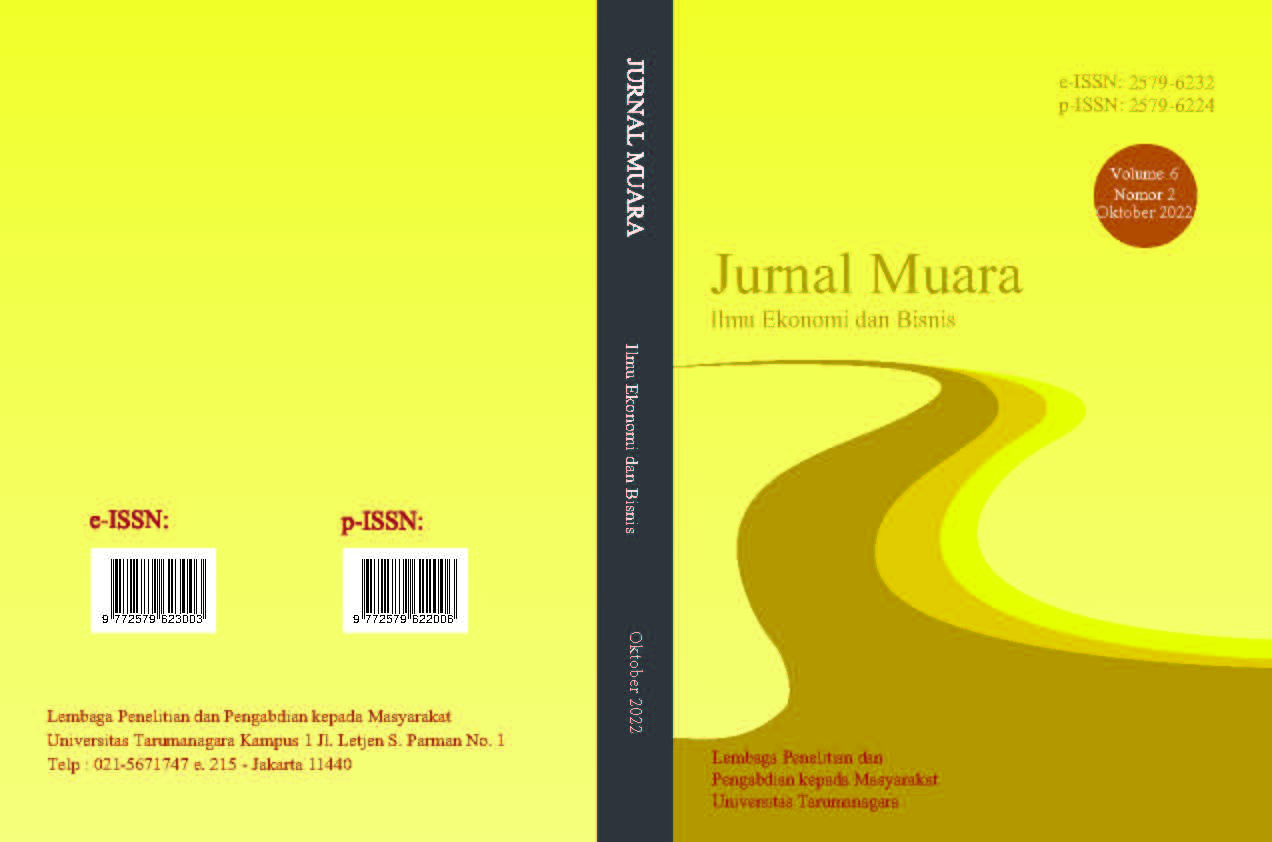FAKTOR-FAKTOR PEMBENTUK PURCHASE INTENTION PRODUK OTOMOTIF "X"
Main Article Content
Abstract
Produk otomotif merupakan salah satu produk yang mengalami dampak pada masa pandemi COVID-19. Penurunan produktivitas penjualan produk otomotif di Indonesia bahkan telah mendorong pemerintah untuk menetapkan kebijakan khusus terkait pajak pembelian kendaraan bermotor baru di Indonesia. Terlepas dari situasi pandemi, pada dasarnya pemasar produk otomotif tetap perlu mengetahui faktor-faktor yang mendorong pembelian produknya. Tujuan penelitian ini adalah untuk menguji faktor-faktor yang diduga membentuk purchase intention produk otomotif, meliputi brand experience, brand image, brand trust dan brand attachment. Sampel penelitian ini terdiri dari konsumen otomotif merek X yang berada di wilayah Jakarta. Terdapat sebanyak 200 responden yang berpartisipasi dalam survey online yang disebarkan melalui google form. Data yang diperoleh kemudian diolah dengan menggunakan software SMARTPLS3. Hasil penelitian menunjukkan bahwa terdapat pengaruh yang signifikan secara statistik dari brand experience, brand image, brand trust, dan brand attachment pada purchase intention produk otomotif X. Implikasi hasil penelitian secara teoretis dapat memperluas pengetahuan terkait intensi pembelian produk otomotif. Secara praktis, hasil penelitian dapat menjadi masukan bagi produsen produk otomotif dalam menyusun strategi untuk dapat meningkatkan intensi pembelian konsumen.
Automotive products are one of the products that have experienced an impact during the COVID-19 pandemic. The decline in sales productivity of automotive products in Indonesia has even prompted the government to establish a special policy regarding the tax on the purchase of new motor vehicles in Indonesia. Apart from the pandemic situation, basically, automotive product marketers still need to know the factors that encourage the purchase of their products. The purpose of this study is to examine the factors that are thought to shape the purchase intention of automotive products, including brand experience, brand image, brand trust and brand attachment. The sample of this study consisted of automotive consumers with the X brand in the Jakarta area. There were as many as 200 respondents who participated in an online survey distributed via google form. The data obtained was then processed using SMARTPLS3 software. The results showed that there was a statistically significant effect of brand experience, brand image, brand trust and brand attachment on purchase intentions of X automotive products. The theoretical implications of the research results can expand knowledge related to factors affecting purchase intentions of automotive products. Practically, the research results can give suggestions for automotive product manufacturers in formulating strategies to escalate consumers' purchase intentions.
Article Details

This work is licensed under a Creative Commons Attribution-NonCommercial-ShareAlike 4.0 International License.
This work is licensed under a Jurnal Muara Ilmu Ekonomi dan Bisnis Creative Commons Attribution-ShareAlike 4.0 International License.References
Bian, X. and Moutinho, L. (2011), "The role of brand image, product involvement, and knowledge in explaining consumer purchase behaviour of counterfeits: Direct and indirect effects", European Journal of Marketing, Vol. 45 No. 1/2, pp. 191-216. https://doi.org/10.1108/03090561111095658
Brakus, J.J., Schmitt, B.H., & Zarantello, L. (2009). Brand experience: What is it? How is it measured? Does it affect loyalty? Journal of
Marketing, 73(3), 52–68.
Delgado, B., Elena, dan Jose. (1999). Brand trust in the context of consumer loyalty. European Journal of Marketing, 35(11/12), pp. 1238-1258.
Delgado-Ballester, E. dan Manuera-Aleman, J.L. (2005). Does brand trust matter to brand equity. The Journal of Product and Brand Management, 14(2/3), pp. 187-196.
Diallo, M.F. and Siqueira Jr, J.R. (2017), "How previous positive experiences with store brands affect purchase intention in emerging countries: A comparison between Brazil and Colombia", International Marketing Review, Vol. 34 No. 4, pp. 536-558. https://doi.org/10.1108/IMR-07-2014-0224
Ha, H.Y., & Perks, H. (2005). Effects of consumer perceptions of brand experience on the web: Brand familiarity, satisfaction and brand trust. Journal of Consumer Behavior, 4(6), 438-452.
Huang, C.C. (2017). The impacts of brand experiences in brand loyalty: Mediators of brand love and trust. Management Decision, 55(5), 915-934.
https://kemenperin.go.id/artikel/22929/Pandemi-Menghadang,-Kinerja-Industri-Otomotif-Melaju-Kencang
Ivanko, B dan Tunjungsari, H.K. (2018) "Pengaruh Kemasan Terhadap Minat Beli Masyarakat Dengan Kualitas Sebagai Variabel Mediasi Pada Produk “Legit”." Jurnal Manajemen Bisnis dan Kewirausahaan, Vol. 2 (6), 53-59. http://dx.doi.org/10.24912/jmbk.v2i6.4908
Jung, L.H., & Soo, K.M. (2012). The effect of brand experience on brand relationship quality. Academy of Marketing Studies Journal, 16(1), 87-98.
Keller, K.L. (1993). Conceptualizing, measuring, and managing customer-based brand equity, Journal of Marketing, 57, 1-22.
Khan, I. and Rahman, Z. (2016), "E-tail brand experience’s influence on e-brand trust and e-brand loyalty: The moderating role of gender", International Journal of Retail & Distribution Management, Vol. 44 No. 6, pp. 588-606. https://doi.org/10.1108/IJRDM-09-2015-0143
Kim, R. B., & Chao, Y. (2019). Effects of brand experience, brand image and brand trust on brand building process: The case of Chinese millennial generation consumers. Journal of International Studies, 12(3), 9-21. doi:10.14254/2071- 8330.2019/12-3/1
Low, G.S., & Lamb, C.W. Jr. (2000). The measurement and dimensionality of brand associations. Journal of Product & Brand Management, 9(6), 350-70.
Mabkhot, H.A., Shaari, H., & Salleh, S.M. (2017). The influence of brand image and brand personality on brand loyalty, mediating by brand trust: An empirical study. Journal Pengurusan, 50, 1-18.
Park, J. and Stoel, L. (2005), "Effect of brand familiarity, experience and information on online apparel purchase", International Journal of Retail & Distribution Management, Vol. 33 No. 2, pp. 148-160. https://doi.org/10.1108/09590550510581476
Persson, N. (2010). An exploratory investigation of the elements of B2B brand image and its relationship to price premium. Industrial Marketing Management, 39, 1269-1277.
Schembri, S. (2009). Reframing brand experience: The experiential meaning of Harley-Davidson. Journal of Business Research, 62(12), 1299-1310.
Schmitt, B., Brakus, J.J., & Zarantonello, L. (2015). From experiential psychology to consumer experience. Journal of Consumer Psychology, 25(1), 166-171.
Sherry, J.F. (2005) Brand meaning. In: A.M. Tybout and T. Calkins (eds.) Kellog on Branding. Hoboken: John Wiley & Sons, pp. 40–69.
Wu, Chao Sen; Chen, Tien-Tze (2019) : Building brand's value: Researchon brand image, personality and identification, International Journal of Management, Economicsand Social Sciences (IJMESS), ISSN 2304-1366, IJMESS International Publishers, Jersey City,NJ, Vol. 8, Iss. 4, pp. 299-318,http://dx.doi.org/10.32327/IJMESS/8.4.2019.19
Oscar, Y., Keni (2019). Pengaruh brand image, persepi harga, dan service quality terhadap keputusan pembelian konsumen (22) DOI: http://dx.doi.org/10.24912/jmieb.v3i1.3300






